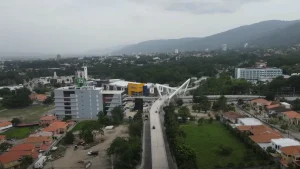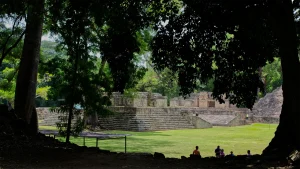Hydrography of Atlantida
In Atlántida, the mouths of several rivers from the Caribbean Sea slope can be found, some of which have their origins in mountains located in other departments.
In this department, as in the rest of the country, rivers not only bring great benefits for the development of communities but also serve as natural borders between them.
The main rivers of Atlántida are the Ulúa, Lean, San Juan, Cuero y Salado, Cangrejal, and Papaloteca.
Rivers of the department of Atlántida
- Ulúa River: It serves as the border between the departments of Atlántida and Cortes. It has a length of 300 km and receives an average annual precipitation of 1,550 mm. Its hydrographic basin covers one-fifth of the national territory. The Ulúa River drains the Sula Valley and forms a delta between Puerto Cortés and Tela. Its waters are used for irrigation of agricultural and livestock fields, domestic and industrial consumption, electrification, dams, and various types of lakes. Its waters flow through 10 out of the 18 departments of the country, accounting for 55% of the national territory. The Ulúa River also has historical and anthropogeographical significance, as remnants of pre-Columbian and Spanish cultures have been found in its various valleys.
- Lean River: It originates in the mountains of the Nombre de Dios range, specifically in the mountain of Nombre de Dios in the municipality of Tela. It serves as a boundary between the department of Yoro and this municipality. It has a course of 60 km and a basin area of 1,885 km². It receives an average annual precipitation of 2,130 mm. At its mouth, near the small port of San Cristóbal, it forms the Barra Colorado. Its tributaries include the Texiguat, Mezapa, and Jilamito rivers on the right bank, and the Alao and Cangélica rivers on the left bank. The Lean River drains the valley of the same name, which is very fertile and has been utilized by the Standard Fruit Co. for banana cultivation and the construction of railway lines to transport fruit from other farms. The Lean River has made a valuable contribution to the development of the communities in Atlántida, ultimately flowing into the Caribbean Sea.
- San Juan River: It divides the municipalities of Esparta and La Masica. Along with other streams such as Nutria, Cuero, Agua Caliente, Santiago, Salado, Colorado, Bonito, and Danto, it drains the plain of La Masica, which is highly fertile and used for pineapple and banana cultivation.
- Cuero y Salado River: These two parallel rivers originate in the Nombre de Dios mountains and flow through the municipalities of Esparta and La Masica. They converge to form the Barra del Río Cuero y Salado, which also encompasses the municipality of San Francisco. This area has high tourism and scientific potential as it serves as a wildlife refuge.
- Cangrejal River: This river has a length of approximately 30 km. Its main sources are in the Yaruca stream, which originates in the Mico Moto mountains of the Nombre de Dios range. It drains the La Masica plain along with other rivers, crosses the municipality of La Ceiba, and has the Viejo and Blanco rivers as tributaries. It flows into the sea near the port city of La Ceiba, forming the Barra Cangrejal.
- Papaloteca River: It originates in the Mico Blanco mountains and has a course of 30 km. It is significant because its course has widened the coastal plain. It flows through the municipality of Jutiapa and its tributaries include the Tómala and Jutiapa rivers. It empties into the sea in front of the Cayos Cochinos.
- Limón River: It is known as Perla in La Ceiba and Jalan and Sambunango in Jutiapa. These names change when these rivers merge with another river, not only in their course but also in their name. They are important because they help maintain the flow of the aforementioned rivers.
- Other rivers: Naranjo, Plátano, Texiguat, Mezapa, and Alao rivers in the municipality of Tela.
Lakes
- Laguna Quemada or de Los Micos: This lagoon is a coastal lagoon and is located to the west of Tela. It drains into the sea through a natural channel between the villages of San Juan and Tornabé. It is fed by small streams that originate from the mountains in the south. It is abundant in fish and is part of the Tornasal tourist project and the Bay of Tela.
- Laguna Tinta: Located between Punta Sal and a stream called Tinto. Its rounded shape and its mouth opening to the sea make it a shelter for small boats when threatened by storms.
- Laguna de Toloa: It is located in the westernmost part of the department of Atlántida, between Laguna de Los Micos and the Ulúa River. It receives numerous streams and drains into the Ulúa River through a natural channel. It is 5 kilometers long and 3 kilometers wide.
- Laguna el Diamante: This lagoon is part of the tourist circuit of Tornasal and the Bay of Tela. It is located between Laguna de Los Micos and Barra de Ulúa, specifically on the south side of Punta Sal in the municipality of Tela.
- Laguna Negra: It is located in the municipality of Tela, between Laguna de Los Micos and Punta Izopo.
See also
- Department of Atlántida
- History of the Department of Atlántida
- Flora and Fauna of Atlántida
- Orography of Atlántida




